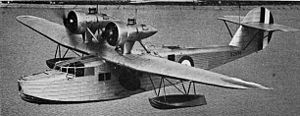Saro Cloud Video - Picture

|
|
Saro A.19 Cloud

Picture - A Saro Cloud of the Royal Air Force
Role: Flying boat
Manufacturer: Saunders-Roe
First flight: 1930
Primary user: Royal Air Force
Number built: 22
The Saro Cloud was a British passenger amphibian flying boat designed and built by Saunders-Roe as the A.19 and later produced as the A.29 for the Royal Air Force for pilot and navigator training.
Development
Following on from the success of the A.17 Cutty Sark the company designed an enlarged version designated the A.19 Cloud. It had room for a crew of two and eight passengers and like the Cutty Sark was a twin-engined monoplane flying boat with two engines strut-mounted above the wing. The design allowed for flexibility in engine fits and a four aircraft were sold to private operators with different engines fitted.
First flown in 1930 the prototype was fitted with two 300 hp (224kW) Wright J-6 radial engines. The Air Ministry ordered a prototype and 16 production aircraft for the Royal Air Force as pilot and navigator trainers. There was room for a crew of two and the former luxury cabin was replaced with chart tables for training six navigators at a time.
Variants
A.19/1 Prototype registered G-ABCJ with 300 hp (224 kW) Wright J-6 radial engines, sold in Canada as CF-ARB, but returned to Saro in 1934 for use as an engine test bed. It was fitted with 340 hp Napier Rapier IV engines and an auxiliary aerofoil behind and below the engine nacelles. It was loaned to Jersey Airways in 1935 before being withdrawn from use in 1936. A.19/2 Special variant powered by three 215 hp Armstrong Siddeley Lynx IVC engines and registered G-ABHG. Due to problems with the engine installation it was re-engined with two 425 hp (317 kW) Pratt & Whitney Wasp C radials before delivery. It was also fitted with an auxiliary aerofoil above the engines and twin fins and rudders to improve directional control. Sold to Imperial Airways in 1940 as a crew trainer but damaged beyond repair in 1941 and scrapped. A.19/3 Prototype for the Royal Air Force with serial K2681 and powered by two 340 hp (254 kW) Armstrong Siddeley Serval III radials. It was followed by sixteen production aircraft for the RAF, numbered K2894-2898, K3722-3729, K4300-K4302. A.19/4 Registered G-ABXW with 300 hp (224 kW) Wright J-6 radial engines. Named 'Cloud of Iona'. It was operated by British Flying Boats Ltd for joy-riding and charter flights, and briefly trialled a service between Glasgow and Belfast. In 1935 it was operated by Spartan Air Lines, and later used by Guernsey Airways until lost off Jersey on 31 July 1936. A.19/5 Powered by two Armstrong Siddeley Serval III and registered G-ACGO. First flown in 1933 it went on a sales tour of Europe and was sold to the Czechoslovak State Airline as OK-BAK and re-engined with Walter Pollux radials. The fuselage is preserved at the Kbely Aircraft Museum, Prague A.29 Production run of RAF aircraft
Operators
Civil operators
Private individuals in Canada and the United Kingdom and the following commercial operators:
Czechoslovakia
Czechoslovak State Airline
United Kingdom
British Flying Boats
Guernsey Airways
Imperial Airways
Jersey Airways
Spartan Air Lines
Military operators
United Kingdom
Royal Air Force
No. 48 Squadron RAF
Specifications (A.29 Cloud)
Data from The Illustrated Encyclopedia of Aircraft (Part Work 1982-1985). Orbis Publishing. pp. 2879.
General characteristics
Crew: two pilots
Capacity: 4 to 8 trainees depending upon role
Length: 50 ft 11½ in (15.28 m)
Wingspan: 64 ft (19.51 m)
Height: 16 ft 5 in (5 m)
Wing area: 650 ft² (60.39 m²)
Empty weight: 6,800 lb (3,804 kg)
Loaded weight: 9,500 lb (4,310 kg)
Powerplant: 2x— Armstrong Siddeley Serval III radial piston engine, 340 hp (254 kW) or A.S. Serval V of same power each
Performance
Maximum speed: 118 mph (190 km/h)
Range: 380 miles (612 km)
Service ceiling: 14,000 ft (4,265 m)
Rate of climb: 750 ft/min (3.8 m/s) initial
Endurance: 4 hours
Armament
Guns: Provision for 0.303 in (7.7 mm) Lewis machine guns in bow and rear positions
Bombs: 4 x 50lb (22.7kg) practice bombs
Doyle, Neville. 1991. From Sea-Eagle to Albatross: Channel Island Airlines 1923-1939. ISBN 185421103X
Doyle, Neville. 2002. The Triple Alliance: The Predecessors of the first British Airways. Air-Britain. ISBN 0851302866
Taylor, Michael J. H. (1989). Jane's Encyclopedia of Aviation. London: Studio Editions.
The Illustrated Encyclopedia of Aircraft (Part Work 1982-1985). Orbis Publishing. pp. 2879.
Jackson, A.J. (1974). British Civil Aircraft since 1919 Volume 3. London: Putnam. ISBN 0 370 10014 X.
Thetford, Owen (1957). Aircraft of the Royal Air Force 1918-57 (1st edition ed.). London: Putnam.
Saro Cloud Pictures
More airplane videos.
Source: WikiPedia